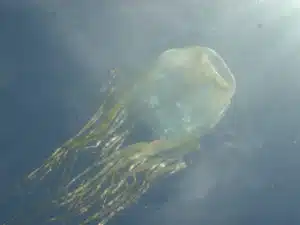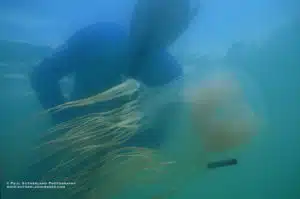Box jellyfish are capable of moving several kilometres a day, but seem to stay within a relatively short stretch of beachfront. Those are some to the initial findings of a young researcher in North Queensland, who is undertaking the first detailed study of the movements of the potentially lethal animals.
Matt Gordon of the Tropical Australian Stinger Research Unit at James Cook University in Cairns is using the latest ultrasonic technology to track the jellyfish. He aims to make Australia’s tropical beaches safer by developing a computer model capable of predicting where and when they will occur.
“There are several long held theories regarding where box jellyfish are found and why they move from one area to another,” Gordon says. “But until now there has been limited evidence to support them.
“For instance, as early as the 1960s it was suggested that box jellyfish swim up creeks towards the end of the season to reproduce. But until we followed a large, sexually mature individual up an estuary near Tully in April of this year, there was no hard data on this.”
In order to record their movement patterns, each box jellyfish is fitted internally with an ultrasonic tag using a type of surgical glue called Histoacryl. Each tag emits a unique signal that can be heard underwater using a hydrophone. It is now possible to track the movement patterns 24 hours a day, 7 days a week using new submersible ultrasonic receivers developed in the US.
By collecting data from four different locations, Matt Gordon intends to develop a model that can be applied throughout the tropics. It is anticipated that such a model will be of benefit to local councils and the tourism industry by allowing stinger enclosures, tourist attractions and resorts to be placed in safer areas.
Matt is one of 13 Fresh Scientists presenting their research to the public for the first time thanks to Fresh Science, a national program hosted by the State Library of Victoria. One of the Fresh Scientists will win a trip to the UK courtesy of the British Council to present his or her work to the Royal Institution.






 Fresh Science is on hold for 2022. We will be back in 2023.
Fresh Science is on hold for 2022. We will be back in 2023.